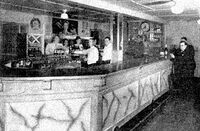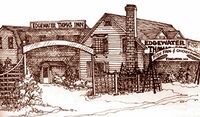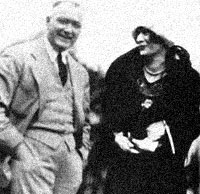The Rendezvous, television series pitch/Episode loglines
A logline (aka elevator pitch) is a one or two line plot summary.
Work in progress
Rather than directly adapt The Rendezvous screenplay, an unpublished feature screenplay by Jason Carswell, after many years of not looking at my script or copious notes I'm going to first outline (and maybe draft a treatment of) the story, in part from memory and new in part to fit this series format and limit the settings (and to prep for a stage play version), to see what new gems may turn up before polishing.
At present, 12 or 13 episodes of about 10 minutes each (plus credits), would add up to 120 to 130 minutes - like a movie, but not.
Historical accuracy
Great care was taken to have as few anachronisms as possible in developing The Rendezvous screenplay. In developing this television series we should try too, but may find more liberty in the oldest third taking place between 1922 and 1929, undefined by not mentioning dates or current events.
The road now known as Riverside Drive East would have been a primitive road until it evolved from dirt to gravel then its current Tarmacadam surface, as would the road surface markings. Further local timeline research is required to apply to this story's three eras. Similarly, the interior and exterior of The Rendezvous Tavern evolved over time, as did the owners.
Copyrights
- Jason Carswell grew up on Lake St. Clair at 11080 Riverside Drive, half-way between Sand Point Beach and The Rendezvous Tavern at the border of Windsor and Tecumseh, Ontario (across the lake from Grosse Pointe).
- Jason Carswell developed this story over decades into this original fictional story based in a lot of anecdotal and factual research.
- Jason Carswell is obviously sharing this story online on his Projex.Wiki website.
- Jason Carswell does not have an army of lawyers to protect this intellectual property.
- Jason Carswell requests that anyone who "borrows" elements or further develops his content would contact and include him in their projects, lucrative or not.
Episode 1 - Sinking! (1922)
From the blustery winter outdoors, boys burst into The Rendezvous roadhouse tavern with alarming news.
Venturing out onto the frozen Lake St. Clair, the men and boys find a stuck old jalopy weighed down with whisky perilously in danger of plunging into the frozen depths.
Despite several attempts with different ideas, the subtle and not-so-subtle racist men in various states of sobriety finally free the vehicle to continue its smugglers' journey - thanks to the clever logical ideas of Cliff, the Black employee of The Rendezvous.
Episode 2 - Packing (1943)
- - Packing for war
Episode 3 - Grind (1967)
- - Auto grind
Episode 4 - Domestic (1922, 1943, 1967)
Strife (1922)
At home, Cliff's wife, Rose, incessantly challenges his manhood for failing to better stand up to the racists and get a pay raise.
"Why did I even tell you?..." Tensions rise.
She clips him with a cast iron pan and his response begins by smashing her head that creates a large hole in the kitchen wall as their children witness in horror.
Ruby, the girl and Clay, the boy...
Dishes (1943)
Clay, the man...
- -
Clay, the man...
Won't (1967)
Clay, the old man...
- -
Episode 5 - Wire (1922)
Touring musician Fats Waller is tickling the ivories at The Rendezvous as patrons drink.
Some fellas are setting up an important meeting that will soon take place at The Rendezvous.
"So I says to him, I says, 'Handy to be so near the river's current that'll sweep away your trash.' You see?"
- until the boys come down from the upstairs lookout to announce the arrival of police.
- - Alarm Wire light
Episode 6 - Tensions (1943)
- - Having a riot
Episode 7 - Discontent (1967)
- - Seeds of discontent
Episode 8 - Roadhouses (1922, 1943, 1967)
Ain't misbehavin' (1922)
Everyone pitches in to clean up after the entire bar rotates to hide in the wall.
Fats starts adlibbing what would become one of his famous tunes, as the police enter asking questions but are only rewarded with fries, like the boys, plus a subtle bribe.
Patriarch ache (1943)
- -
Supremes (1967)
- -
Episode 9 - Family tree
- Optional 1800s bonus episode.
- -
Episode 10 - Tanks in Detroit (1967)
- -
Episode 11 - Father's funeral (1943)
- -
Episode 12 - Gangsters rendezvous (1922)
- -
Episode 13 - Wealth of generations (1922, 1943, 1967)
Quietly healing (1922)
Through the blizzard Cliff trudges home alone, in the dark.
Cliff finishes patching up the wall, he quietly tidies the kitchen, and puts his tools away.
Cliff slips into bed, Rose rolls over, and they embrace in silence.
Sins are forgiven.
Real riches (1943)
- -
Diamonds! (1967)
- -
Reference
Wikipedia links, unless otherwise noted:
1922
- Ain't Misbehavin' (song)
- "Ain't Misbehavin'" is a 1929 stride jazz/early swing song. Andy Razaf wrote the lyrics to a score by Thomas "Fats" Waller and Harry Brooks for the Broadway musical comedy play Connie's Hot Chocolates (opened June 20, 1929). As a work from 1929 with its copyright renewed, it will enter the American public domain on January 1, 2025.
- Boardwalk Empire, an HBO television series, 2010-2014
- Diamond#Gem-grade diamonds, are a controlled centralized trade artificially inflating the value of a semi-precious gem through marketing
- De_Beers#Marketing, 'A Diamond is Forever', 1947
- Diamonds Are a Girl's Best Friend, song in Gentlemen Prefer Blondes the 1949 musical and 1953 movie
- Diamonds Are Forever (1956 novel)
- Diamonds Are Forever (1971 film)
- De_Beers#Marketing, 'A Diamond is Forever', 1947
- Jewish-American organized crime
- Joseph Zerilli
- Meyer Lansky, oddly doesn't mention anything about his government and CIA connections
- Murder, Inc.
- Racketeering
- The Purple Gang, aka Sugar House Gang
- Prohibition#North America
- Prohibition in Canada
- Prohibition in the United States
- Rum-running
- Speakeasy, aka blind pig or blind tiger
- Teetotalism
- Riverside, Ontario#Historical and the Grand Taverns of Riverside:
- Edgewater Thomas Inn
- Island View Tavern (known as Abars)
- Lauzon Stop House
- Menard's Tavern
- Rendezvous Tavern
- Wolf's Hotel
- Pub#Roadhouse
1943
- 1943 Detroit race riot, Sunday June 20 - Tuesday June 22, 1943
- Belle Isle Park
- MacArthur Bridge (Detroit), 1923+, replaced an iron bridge with wooden decking that accidentally caught fire and was destroyed in 1915. The bridge, popularly known as the Belle Isle Bridge, was originally named the George Washington Bridge and renamed the Douglas MacArthur Bridge after General Douglas MacArthur in 1942.
- Detroit Diesel Series 71, 1938–1995
- Harry Houdini#Death, (1874 - Halloween 1926)
- Naval Air Station Grosse Ile, 1929 - 1969
1967
- 1967 Detroit riot, Sunday July 23, 1967 - Thursay July 27, 1967, aka The 12th Street Riot
- "Black Day in July" – 4:10 - Side 1, Track 3 on the album: Did She Mention My Name?
- By Gordon Lightfoot on YouTube
- Covered by The Tragically Hip on YouTube
- "Black Day in July" – 4:10 - Side 1, Track 3 on the album: Did She Mention My Name?
- Detroit Renaissance
- Renaissance Center, 1973 - 1977+
- Civil rights movement, 1954 - 1968
- Civil rights movement in popular culture
- List of civil rights leaders
- Malcolm X, 1925 - 1965-02-21
- Martin Luther King Jr., 1929 - 1968-04-04
- List of peace activists
- Detroit dramas
- Detroit history
- Filmmaking
- Historical drama
- Independent media
- Loglines
- Media alternatives
- Media ideas
- Media projects
- Original content
- Pitches
- Production development
- Projects started on 2023-03-06
- Stories set in the 1920s
- Stories set in the 1940s
- Stories set in the 1960s
- Television
- Television series pitches
- The Rendezvous
- The Rendezvous, television series pitch
- Windsor communications
- Windsor dramas
- Windsor dramatic productions
- Windsor entertainment
- Windsor history
- Windsor indie-media
- Windsor media
- Windsor prepper projects
- Windsor video productions
- Windsor videos




